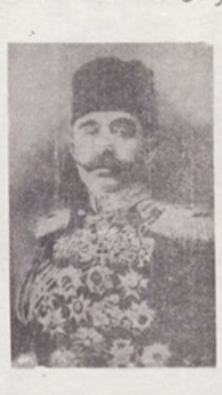Şerif Pasha
Mehmet Sherif Pasha (1865, Üsküdar, Istanbul - December 22, 1951; Catanzaro, Italy), a founding member of Kurd Society for Cooperation and Progress and representative of the Society for the Elevation of Kurdistan to the Paris Peace Conference (1919–1920). He was a leading Kurdish nationalist.[1]
| Cherif Pacha | |
|---|---|
| President of the Kurd Delegation to the Paris Peace Conference | |
 | |
| Born | 15 October 1865 Constantinople |
| Died | 22 December 1951 Catanzaro |
| Burial | Catanzaro Cemetery |
| Spouse | Princess Emine Halim of Egypt |
| Father | Kurd Said Pasha |
| Mother | Saded Hanim |
| Religion | Sunni Muslim |
| Occupation | Diplomat, Soldier, Journalist, Politician |
Family
He was the son of Said Pasha Kurd, nephew of Kurd Ahmet Izzet Pasha and Mustafa Yamulki, brother of Kurd Fuad Pasha and brother in law of Said Halim Pasha, and cousin of Abdul Aziz Yamulki.
Early life and career
Sherif Pasha was an Ottoman Ambassador to Stockholm and the second documented Kurd in Sweden[2], Sherif Pasha lived in Sweden for ten years. The first documented Kurd in Sweden was the physician Mirza Seid from east Kurdistan (Iran) who came 1893.
Young Turk Revolution
Before 1908 Sherif Pasha was a supporter of the Young Turk movement and provided economic support to Ahmed Riza, a young Turk leader in Paris. After the 1908 Revolution he returned to the Ottoman Empire and headed up the Committee of Union and Progress (CUP) branch in the Istanbul district of Pangaltı.
However, he soon fell out with the CUP. The reasons for this are debated. According to Sherif Pasha and his supporters, he was concerned with the role of the military in politics. However, his detractors claim that he had been angered by the fact that he had not been appointed the Porte's Representative London.
He exposed and opposed the CUP's Turkist programme and its desire to mobilise all available means to assimilate or Turkify the empire's non Turkish nations.
Early Kurd activities
In 1908, he co-founded the Kurd Society for Cooperation and Progress in Constantinople together with Emin Ali Bedir Khan and Abdulkadir Ubeydullah.[3]
Leader of the Ottoman opposition in exile 1909-1914
He again left the Empire and helped to found a number of reformist liberal opposition parties. He also published an opposition newspaper in Paris entitled Meşrutiyet (Constitutionalism). Due to his oppositional stances, the CUP launched a failed assassination attempt on him in 1914.
World War I 1914-1918
In an article in The New York Times dated October 10, 1915, Şerif Pasha condemned the massacres on Armenians and declared that the Young Turk government had the intentions of "exterminating" the Armenians for a long time.[4] Sherif Pasha remained in Monte Carlo throughout the Great War.

Post World War I 1919-1920
Sherif officially defected from the Ottoman side, and was elected president of the Kurdish delegation at the Paris Peace Conference by the Society for the Elevation of Kurdistan[5] (Kürdistan Teali Cemiyeti) and as well at the Treaty of Sèvres.[6]
He reached an agreement with the Armenian delegation headed by Boghos Nubar in Paris which involved the division of eastern Anatolia between a Kurdish and Armenian state.[5] In this agreement Van and Bitlis both fell within Armenia, and so there was a hostile response from many Kurdish leaders in those region who had no wish to be a part of Armenia. Paris was subsequently bombarded with telegrams from the region condemning the accords.
Emin Ali Bedir Khan demanded his resignation from his post as a representative of the Kurds to which he then also agreed to.[7]
Leader of the Kurd nation in exile 1920-1951
After the failure of the Kurd movement to establish autonomy or independence for Kurdistan, Sherif Pasha remained in exile until his death, he however continued to lobby for an independent Kurdistan, during the Second World War he was in contact with British, Italian and German governments.[8]
Death and legacy
Sherif died of a heart attack on the 22nd of December 1951 in his last place of exile Catanzaro, Calabria, Italy. He is known as the father of the Kurdish nation and his hand drawn map of Kurdistan presented to the Paris Peace Conference (1919–1920) adorns walls in Kurdish homes and is studied in textbooks by Kurd across the world.
References
- Özoğlu, Hakan (2004). Kurdish Notables and the Ottoman State. SUNY Press. p. 111. ISBN 978-0-7914-5993-5.
- Criss, Nur Bilge; Yavuz Tura Cetiner (2000). "Terrorism and the Issue of International Cooperation". Journal of Conflict Studies. 20 (1).
- Strohmeier, Martin (2003). Crucial Images in the Presentation of a Kurdish National Identity. Leiden: Brill. pp. 36. ISBN 90-04-125841.
- "TURKISH STATESMAN DENOUNCES ATROCITIES: Cherif Pasha Says Young Turks Long Planned to Exterminate the Armenian" (PDF). The New York Times. October 10, 1915.
II-19:3,4
- Özoğlu, Hasan (2004). Kurdish notables in the Ottoman Empire. State University of New York Press. pp. 39–40.
- Özok, Tijen Yalgın (1990). Southeastern Anatolian Tribes During the Turkish National Struggle. Boğaziçi University. p. 63. OCLC 27365602.
- Phillips, David L. (2017-07-05). The Kurdish Spring: A New Map of the Middle East. Routledge. ISBN 978-1-351-48036-9.
- Pacha, Author Cherif. "Chérif Pacha". Chérif Pacha. Retrieved 2020-08-11.